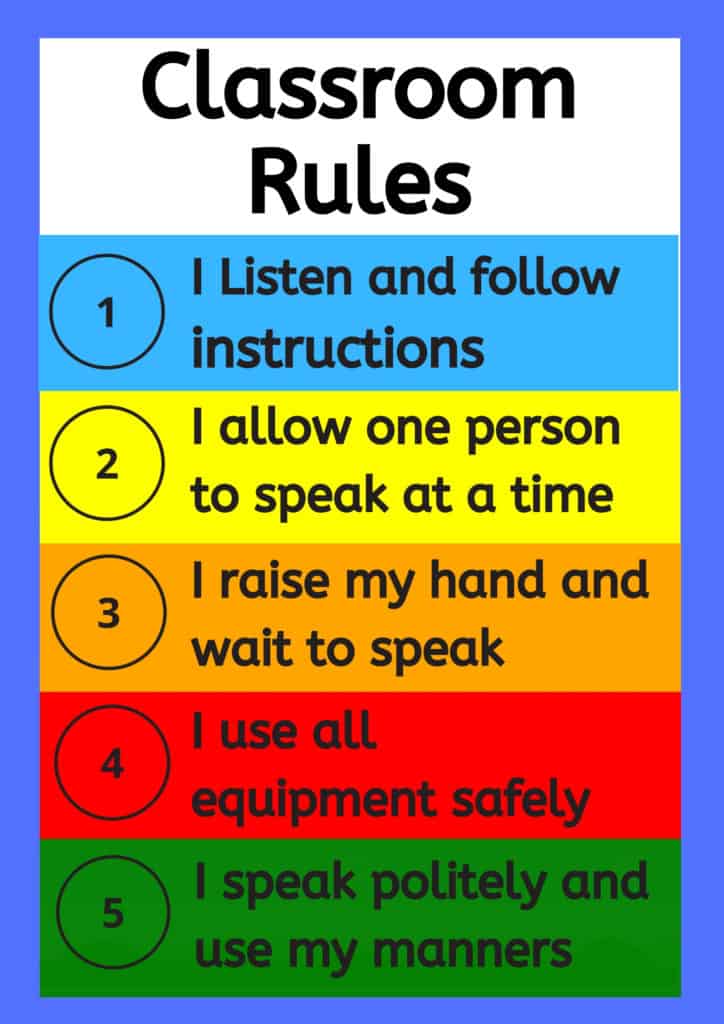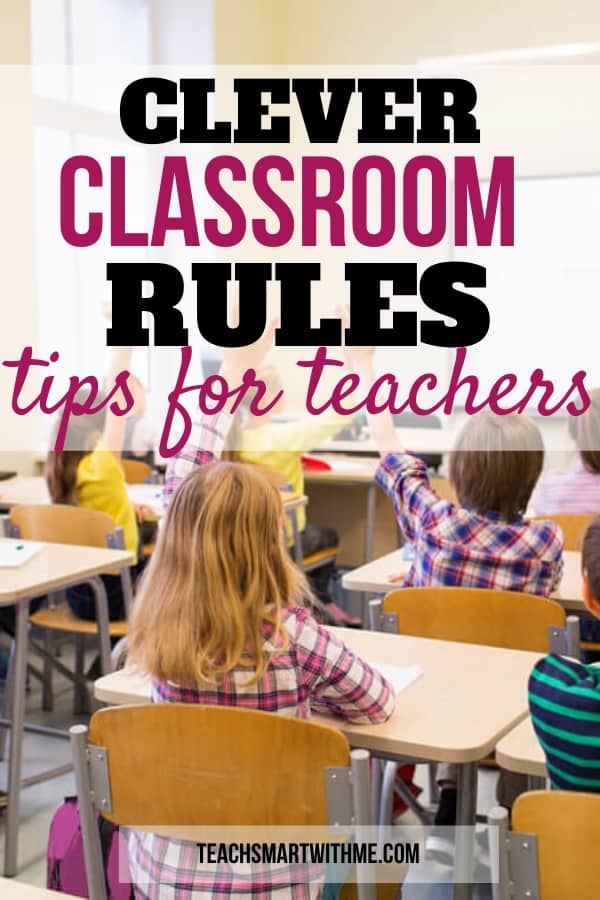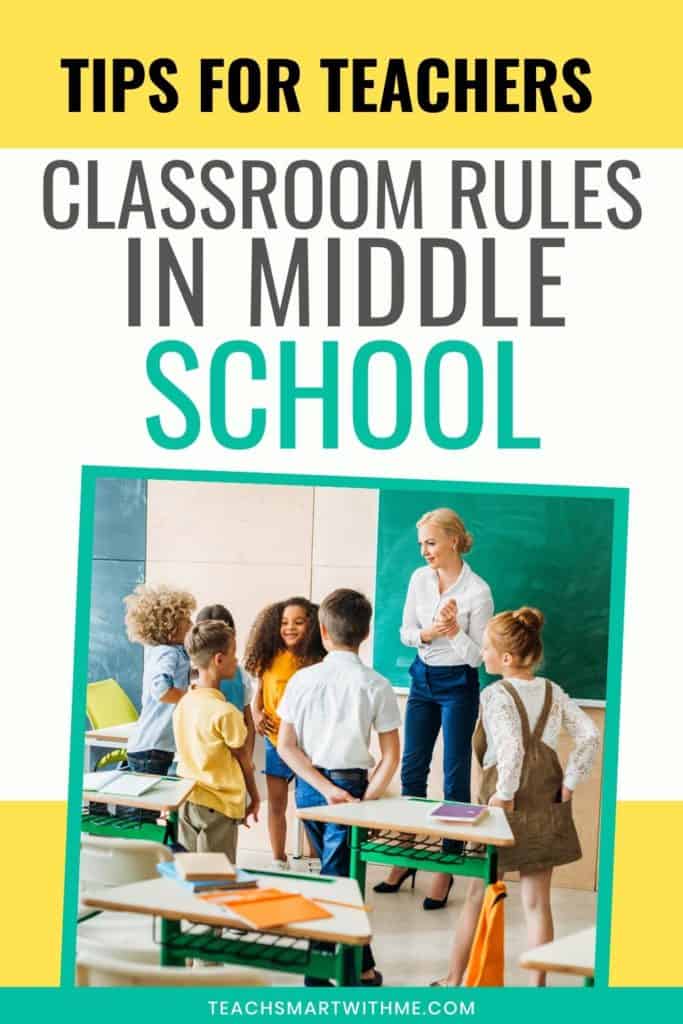Having clearly defined classroom rules in middle school is the key to any successful classroom management plan. Read on for tips for beginning teachers.

The key to classroom rules that work for any age, but particularly for middle school is that you need to first teach them to your students, refer to them often and consistently follow-through.
Rules are not just a ‘set and forget’ type of thing for any class. For them to work well, rules need to follow certain guidelines. Read to find some helpful tips to establish classroom rules in middle school.
How many classroom rules should I have?
Research tells us that for an effective behaviour management plan, the rules that you set should be limited to maybe five statements that are clearly stated.
Each rule should also begin with a verb with only one action per statement.
A good example would be: Follow Instructions
Instead of: You must follow the teacher’s instructions while in the classroom
Subscribe here & have access to a Classroom Rules Cheatsheet to take the guesswork out of setting up your rules; plus other FREE printables:
What types of classroom rules in middle school should I have?
Classroom rules can be very personal to each teacher and often relates to what you find to be important to you.
Some teachers are particular about certain behaviours. For example, I don’t really like students wandering around the classroom at all times and prefer them to stay in their spots unless they have permission – so this would be one of my rules.
Or you might not be concerned about students movement, but really find it important to have honesty at all times; Make this a rule.
Choose five really important rules that you consider you couldn’t do without for your plan to work.
I generally have classroom rules that relate back to the overarching values of my school and have clear connections to them.
For example, one of the whole school values is Respect, so many of my rules relate to this. For example: ‘I raise my hand and wait to speak, is all about the respectful way to speak in the classroom.
So make your rules suit your particular needs.
Related Article: 12 Strategies for a Successful Classroom Management Plan + Freebie
Make classroom rules for middle school a collaborative process
For younger students, you as the teacher can just introduce your own rules and expectations, but you’ll find that as the students get older, they need to understand the relevance of them. This is when you can jointly construct rules as a whole class.
It can be a bit time consuming to discover what rules the students value, but once these have been settled on, they’ll be more effective because when older students have been a part of their implementation, they will take ownership of them.
I suggest student collaboration for middle school age – from maybe year 4 or 5 onwards, but definitely year 6 and above.
A fun activity for classroom rules collaboration:
- hand out 3 sticky notes to each student
- ask them to write their top 3 rules on each note
- when everyone is finished, start to categories the rules by getting students to group them into types on the board. For example, any rules to do with how to speak or ask questions should be grouped together, just as anything to do with the use of equipment would be grouped together etc
- Once students have stuck their notes into their categories on the board, as a class, work together to find the top 5 rules by the number of the sticky notes for each. They then become the whole class rules. (you may have to guide them in this, and have your preferred rules as suggestions if they get a bit stuck for ideas)
Tip: If you have worked with older students, you will understand that their behaviour management can be quite tricky and this strategy is very useful to ensure their adherence to the class rules and their understanding of their value.
How should classroom rules be taught?
For students to understand the value and importance of your classroom rules you also need to have high expectations that each rule be followed.
To do this, classroom rules must be explicitly taught in the first week back to school, followed through in the second week and in subsequent weeks, but not in as much detail.
I then always start each and every term by reviewing school and classroom rules. Revising them after holidays helps keep them fresh in students minds, but also makes children aware of their value.
Consistency is key!
Creative ways for rule revision and memory games
You can have fun with revising the rules too.
Later in the year, I’ll have memory games for students to write down all the classroom rules in a given time frame.
I also have activities where I ask students to pick the rule that is the most important to them and why they think this. We share their ideas as a whole class discussion – very interesting to hear their ideas!
The teaching of classroom rules must be consistently done throughout the year if they are going to be learnt, followed through with and ultimately valued in your room.
Activities can also be carried out where you ask students to model examples of a particular rule. This works well, as they become actively involved and other students can view their classmates acting appropriately. Role-playing of non-examples of classroom rules can also be a valuable activity too.
Classroom rules are only successful with you as the teacher consistently following through.
Sign up for Free resources here:
Example lists of Classroom Rules
If you are pretty new to teaching or you need to change up your classroom rules, here are some lists of rules that can be used to get you started.
Example 1
This list is what I am currently using. I like to add the “I” at the beginning of each statement because I think it creates ownership of each rule.
- I listen and follow instructions
- I allow one person to speak at a time
- I raise my hand and wait to speak
- I use all equipment safely
- I speak politely and use my manners

Example 2
Here’s an example from Thought Co.
- Be respectful to all.
- Come to class prepared.
- Do your best.
- Have a winning attitude.
- Have fun and learn!
Example 3

It’s totally flexible and up to you what rules you set as the classroom teacher.
Don’t forget to display the classroom rules in a very visible place, so that you can refer to them often. Don’t have them hidden behind something that can’t be seen very clearly.
Also, have the font of your rule in a large enough text that is easily readable from the children view.
Making changes to classroom rules
Please remember that even if your classroom rules are not working for you or your class, you can change them any time you want.
Just because it’s partway through the school year, doesn’t mean you can’t make changes. It’s not optimal for continuity, but it is still possible.
You can have a class meeting and be honest with your kids. Tell them if the rules aren’t working. Explain that they will need to be changed and they will have to learn new ones. Or you might just need to tell them that they will need to be practised more often if they are not working as you had hoped.
Everything is fixable!
Get some ideas for classroom rules in the Free Resource Library. Sign up here:
I hope this helps you to set up your classroom rules and have them working well for you. Good Luck.
Michelle x




Leave a Reply